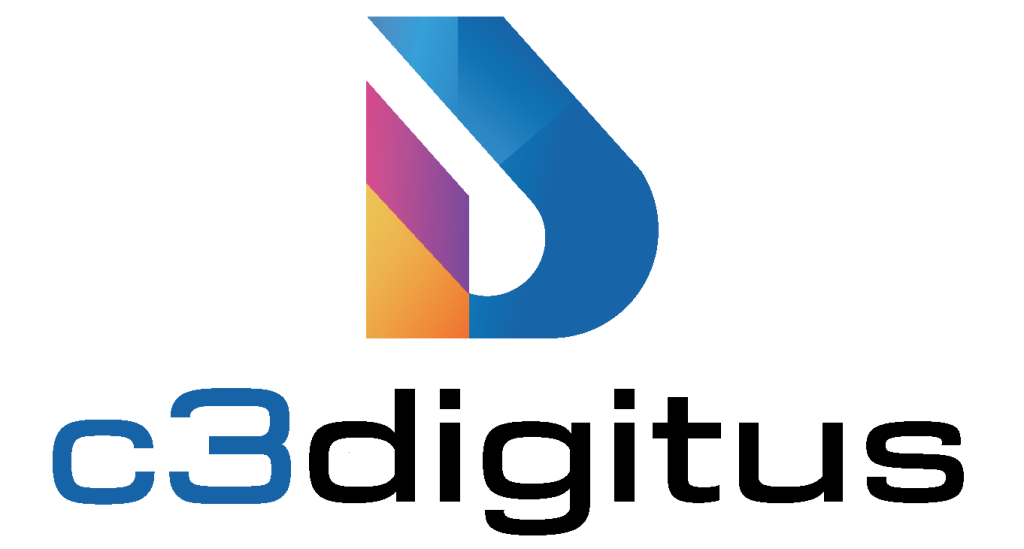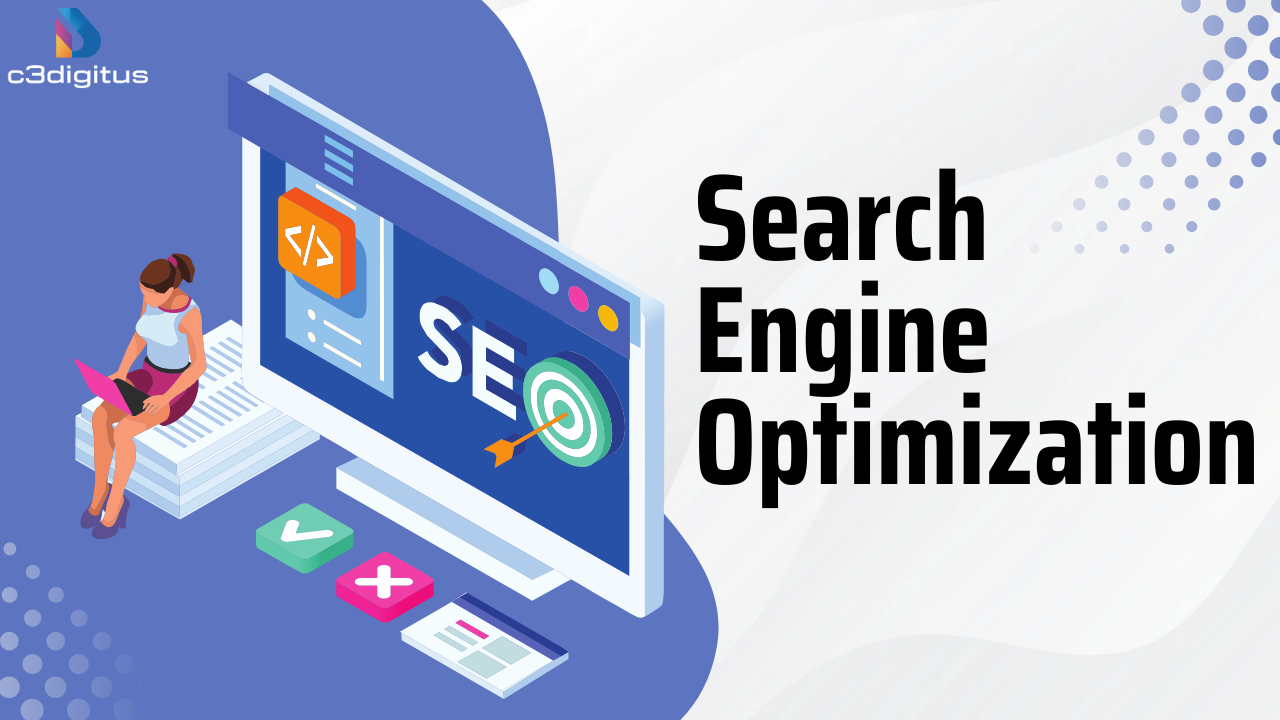In today’s world, it’s crucial for businesses to be easily found online. While having a website is like setting up a store, SEO helps people discover your online store. By applying SEO techniques, you can make your website more visible to potential customers searching for products or services you offer.
Imagine the internet as a massive library filled with countless books. The search engine is like a helpful librarian, guiding you to the right book—or in this case, the right website. SEO makes sure your book, or website, is easy to find and exactly what people are looking for.
What is SEO?
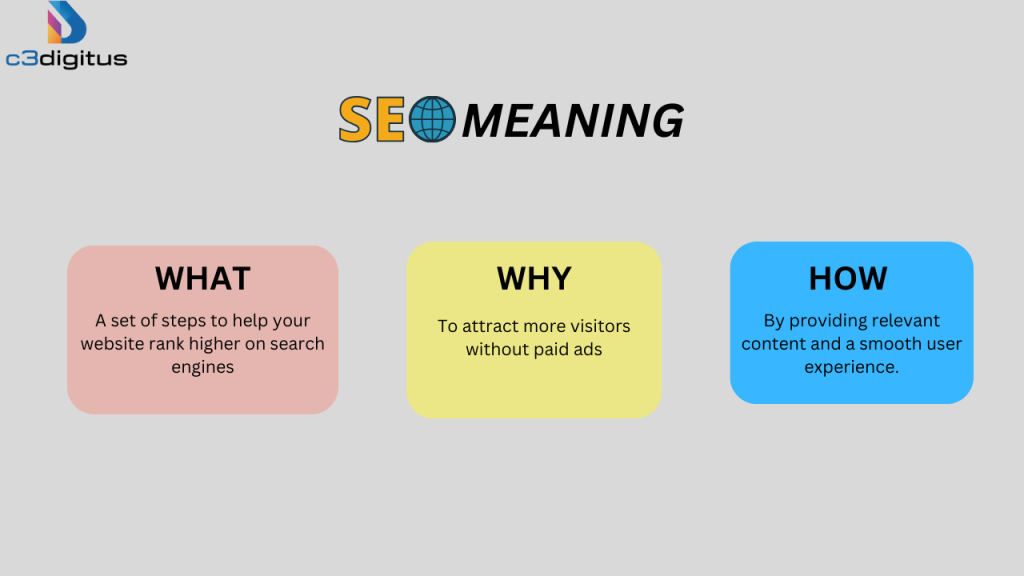
SEO stands for Search Engine Optimization. It is how you make it easier for people to find your website with the use of Internet search engines such as Google, Bing, or Yahoo. It can help if you imagine the Internet as a big library, with gazillions of books. That would be your website.
SEO makes your website visible and relevant through simple strategies that make it outshine all others. Thus, whenever a person searches for anything related to your site, the website will be among the very first to be seen. The basic objective of SEO is to capture more traffic by helping people find exactly what they are looking for.
Types of SEO
There are three main types of SEO: On-Page SEO, Off-Page SEO, and Technical SEO.
On-Page SEO: Creating Quality Content
On-page SEO involves updating your website by refreshing descriptions, writing blog posts, and selecting the right keywords for your page titles. For example, you might add a specific tag to your ‘Services’ page so that when people search for services in your field, your page appears at the top
Essentially, on-page SEO is about optimizing your website’s content, code, and layout to make it easier for search engines to understand. This includes properly using header tags, adding alt text to images, and ensuring your site loads quickly and looks good on mobile devices. These efforts can help your site rank higher and become more visible in search results.
Off-Page: Building Quality Backlinks
Off-page SEO focuses on providing search results for your websites from external sources. An external source is whatever helps to have your website ranked higher, such as a food blogger celebrity writing something about you or Ellen DeGeneres writing a blog post about Oprah Winfrey.
Take, for instance, when Ellen makes links to Oprah’s site or tags her in the post; this will then be seen as support to Oprah’s site by Google and hence better ranking to her. Other examples of off-page SEO activities include: quality link building, social media marketing, guest posting, and influencer marketing. All these strategies work towards establishing website authority and credibility before search engines, which is later manifested in improvements in your search rankings.
Technical SEO: Optimizing Behind the Scenes
Technical SEO is all about the nuts and bolts optimization of a website, which commonly remains unnoticed. It includes increasing site speed, ensuring that your website is well-indexed, developing an easy website structure for the web crawlers to understand, and a few technical issues that might block the search engine crawlers from successfully indexing a website. An optimized website can do simply more than rank higher in search results; it can satisfy users.
Beyond that, technical SEO lays the groundwork for all your other SEO efforts. Even if you have great content and perfect on-page SEO, they won’t shine if your site’s technical foundation isn’t solid. Focusing on mobile-friendliness, using secure connections (HTTPS), and having a clear XML sitemap helps search engines understand and trust your site. This not only improves your rankings but also creates a solid website that can grow with your business.
Local SEO: Enhancing Visibility for Local Searches
Local SEO is an important tool for any business that wants to gain customers around its physical location. It helps improve the visibility of a company online, ensuring the company ranks higher in search results.
For instance, in the image, we see Common Grounds Coffee House & Desserts in Apex, NC, ranking at the top of the local pack for the search “coffee shop near me.

This high ranking can be attributed to a few factors: the proximity of the coffee shop to the searcher, the services it offers, and its strong reputation with a 4.7 rating out of 5 from over 922 reviews.
Further, the listing contains useful information such as operating hours, approximate costs, and an appealing description—”Neighborhood haunt for sweets & brews”—which helps potential clients make a quick decision. It is easy to see how a place like Common Grounds would attract many local searchers, boosting foot traffic and sales in their shop.
You should aim to Optimize your Google My Business Profile for Local SEO by incorporating niche keywords, up-to-date business information, and features that attract more customers, increasing your visibility on search engines.
With proper local SEO tactics, you can even target a spot in Google’s 3-pack—a category where only the top three searched businesses are listed on Google.
International SEO: Reaching Global Audiences
International SEO focuses on improving a website to serve different countries and languages. In contrast to local SEO, it has a global focus, indicating to search engines which countries and languages are appropriate for your business. This strategy is especially useful for companies looking to expand their online presence into new markets. It’s not just about translation; it involves adjusting to geographical variations in language, culture, and global search behavior.
For example, the Spanish language is in high demand and is one of the official languages of the United Nations. Its widespread usage in several countries requires businesses to create specific strategies for markets like Mexico, Colombia, and Spain, based on their unique variations. With the proper implementation of International SEO, your content operation can reach the maximum possible audience.
Why is SEO Important?
SEO is crucial for brand success because it enhances your brand’s online visibility, driving more organic traffic to your website and establishing your brand as a credible authority in your industry.
By optimizing your site for search engines, you increase the chances of appearing at the top of search results, which not only attracts more visitors but also builds trust and credibility with your audience.This heightened visibility helps you differentiate your brand from competitors, fostering a strong and recognizable online presence.
SEO is important for several reasons:
High Visibility And Rankings: If your website is easily found online, it is just like having a big, bright sign on a busy street. More people see your sign, and more people walk in. If your site pops up at the top every time somebody searches for what you are offering, the chances of them clicking your link go up quite substantially. Even if they don’t buy right now, seeing your name so many times helps them remember when they do.
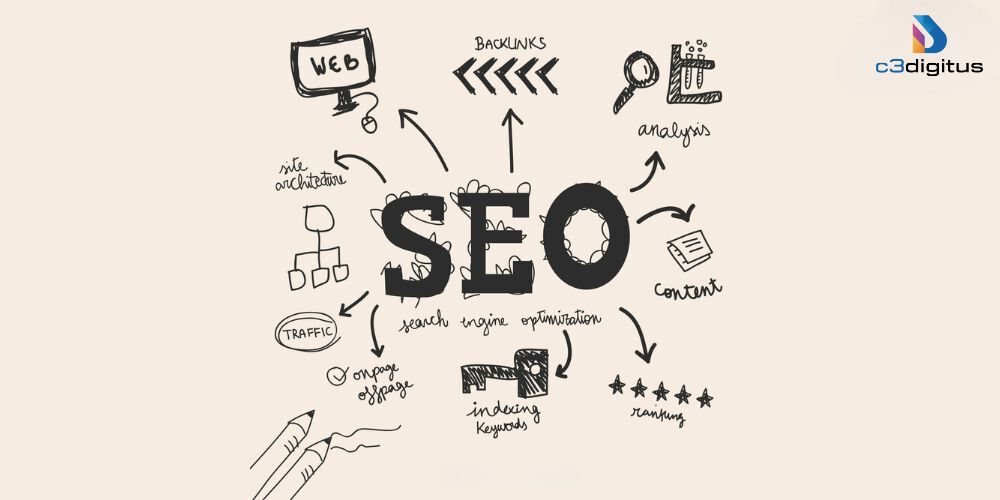
Targeted Traffic: SEO isn’t just about getting more people to your site—it’s about getting the right people. Imagine having a shop that only people looking for your products walk into. SEO helps you attract visitors who are already interested in what you’re selling, which means they’re more likely to make a purchase. It’s like having a sign that says, “If you’re looking for this, you’ve found the right place!”
Cost-Effective: Running ads can quickly get expensive, but SEO is a smart way to bring in traffic without the ongoing costs. Once you’ve done the work to rank well in search engines, people will keep finding you, and you won’t have to keep paying for it. It’s a bit like planting a tree—once it’s grown, it keeps giving you fruit year after year without much extra effort.
Competitive Edge: In today’s world, if you’re not keeping up with SEO, you’re letting your competitors get ahead. If they’re showing up in search results and you’re not, potential customers might not even know you exist. By focusing on SEO, you make sure you’re in the race, not sitting on the sidelines.
Enhanced User Experience: SEO isn’t just about getting people to your site; it’s about making sure they have a good time when they’re there. A well-optimized site loads quickly, is easy to navigate, and clearly shows what you have to offer. When visitors have a positive experience, they’re more likely to stay longer, explore more, and eventually buy something. Plus, when your site is user-friendly, search engines take notice and rank you higher.
Growth: SEO is a major driver of growth for your business. The better your site ranks for important keywords, the more people will find you through organic searches—those are the unpaid ones. This steady stream of visitors gives you more chances to turn them into customers and grow your business. Plus, when people find your site through search, they’re more likely to share it on social media, which can bring in even more potential customers.
Trustworthiness: When your site ranks high in search results, it’s not just about getting more clicks—it’s about building trust. People tend to trust Google’s top suggestions, so if your site is up there, it gives the impression that you’re a reliable, trustworthy business. This trust can be the difference between someone choosing your product over a competitor’s.
How Does it Work?
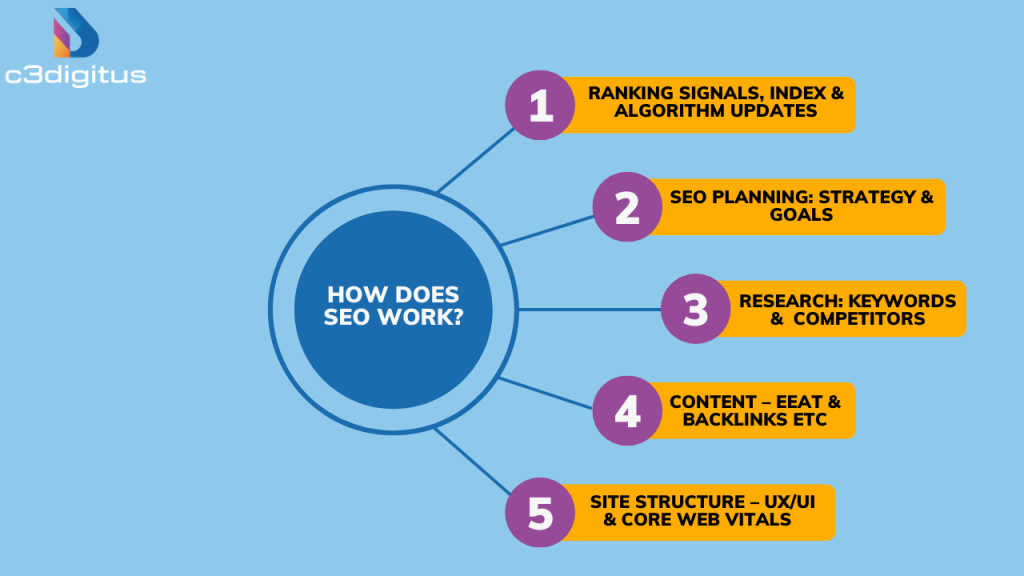
a) How do search engines work? – Ranking Signals, Index, Algorithm Updates
Search engines use very complex algorithms and technology to deliver the best results for any given query. While no one knows exactly how these algorithms work, there are some clues, especially when it comes to Google, allowing us to make targeted optimizations.
The search engine is a software system made after a lot of effort and is a very secure network. Take Google’s example. Can you tamper with Google’s backend? Can you take your website to the top by changing its algorithm or coding? No.
In simple language, you cannot optimize the search engine itself. You optimize your website in a better way so that you can get the best out of the search engines.
- Ranking Signals:
- These are the factors search engines use to decide where your website shows up in search results.
- Things like how fast your site loads, whether it’s mobile-friendly, how many other sites link to it, and how relevant your content is to the search terms all play a part. The better your site matches these ranking signals, the higher it can rank.
- Index:
- Think of the index as a massive library where search engines store information about all the web pages they’ve found.
- When you search for something, the engine quickly looks through this library to find the most relevant pages to show you. So, when a search engine crawls your site, it adds your pages to its index to make them searchable.
- Algorithm Updates:
- Search engines regularly tweak their algorithms—the set of rules they use to rank pages—to improve search results. These updates can change how your site ranks, sometimes requiring you to adjust your SEO approach.
- Major algorithm updates can have a big impact on where your site appears in search results. Understanding these basics can help you navigate SEO and keep your website visible and relevant in search engine results.
Read our recent post about : Google Core Update August 2024
b) SEO Planning: Strategy & Goals
- Strategy:
- Research & Analysis: Start by understanding your target audience, competitors, and the keywords that are most relevant to your business. This includes analyzing what’s currently working (or not) on your website.
- On-Page Optimization: Conduct a quick on-page SEO audit to identify any gaps. Focus on optimizing your website’s content, meta tags, images, and internal links. Ensure that your site is user-friendly, mobile-optimized, and loads quickly.
- Content Creation: Develop a content plan that aligns with your audience’s needs and search intent. This could include blog posts, guides, videos, and other valuable content that answers their questions and keeps them engaged.
- Off-Page Optimization: Build authority through quality backlinks, social media engagement, and partnerships. The more reputable sites link back to yours, the more credible your site becomes in the eyes of search engines.
- Technical SEO: Ensure your site is easy to crawl and index by search engines. This includes improving site structure, fixing broken links, optimizing for mobile, and ensuring secure (HTTPS) connections.
- Research & Analysis: Start by understanding your target audience, competitors, and the keywords that are most relevant to your business. This includes analyzing what’s currently working (or not) on your website.
- Goals:
- Increase Organic Traffic: Aim to boost the number of visitors coming to your site through search engines by targeting the right keywords and optimizing your content.
- Improve Search Rankings: Work towards ranking higher for specific keywords that are important to your business. The higher your site ranks, the more likely people are to find it.
- Enhance User Experience: Ensure that visitors have a smooth and enjoyable experience on your site, leading to longer visit durations, lower bounce rates, and higher conversion rates.
- Boost Conversion Rates: Optimize your site not just for traffic, but for turning that traffic into leads or sales. This could involve improving call-to-actions, landing pages, and overall site usability.
- Monitor & Adjust: Set up tools to monitor your progress, such as Google Analytics and Search Console. Regularly review your results and adjust your strategy as needed to meet your goals.
- Increase Organic Traffic: Aim to boost the number of visitors coming to your site through search engines by targeting the right keywords and optimizing your content.
By aligning your strategy with these goals, you can create an SEO plan that drives measurable results and helps your business grow online.
c) Research: Keywords and Competitors
Keyword Research: Keyword research involves finding the exact words and phrases potential customers use to search for the products or services on offer. Below is a simple guide on how to go about it:
- Start Simple Ideas: The first thing to do is to brainstorm a few basic terms that describe your business. For instance, if you sell environment-friendly products, you could brainstorm over “sustainable products” or “green living.”
- Make Use of the Available Aids: There are aids like Google Keyword Planner or SEMrush that help you flesh out your basic ideas. They show you the frequency with which people search using different terms and the competitiveness of those terms. Be more exact, such as “best eco-friendly cleaning products.” These bring in not as many searches, but these are the users who are a little closer to making a purchase.
- What Do People Want? Think about the intent behind each keyword. Are they looking to buy something, learn more, or just look around? Be sure you make your content fit what people are looking for.
- Decide Where to Focus: Put the great bulk of your effort toward those keywords that are central to your business and for which you have some chance of ranking well. Look for the sweet spot where a keyword is popular enough to be worth your time but not so competitive that you’ll never rank for it.
- See What Competitors Are Doing: Have a look at what keywords your competitors are targeting. This can give you ideas for keywords you might be missing or ways to outmaneuver them.
Research on Competitors:
Constantly keep eyes on the competitors to stay ahead of the game. Here is what you need to do:
- Recognize Your Competitors: First, figure out who your main competitors are. These are businesses offering the same services and products as you, or those that target the same audience but use a different route.
- Audit Their Websites: Perform a comprehensive website audit, take a detailed look at their websites to evaluate the organization of their content, the topics they cover, and the keywords they target. This will help you understand their strategy and identify areas for improvement.
- Check Their Backlinks: Backlinks are links from other websites that point to theirs. You can see where their backlinks are coming from and think about how you can get similar links.
- Study Their Content: What type of content are they producing? Are they writing blog posts, creating videos, or other? What works for them and where can you create better or different content?
- Evaluate Their Performance: This is the measurement of their performance against your metrics, using tools available to cross-reference with things like the amount of traffic they are getting and the strength of their site in general.
- Seek out Opportunities: Once you have your research done, find areas where you can do better. Maybe they don’t cover a topic that you can, or maybe the structure of their website isn’t as user-friendly as it could be. Use those insights to your advantage.
By researching keywords and competitors in detail, you stand in good stead to attract the right people to your site and stand out in your market. This research will help you make more informed decisions for your content, website, and strategy.
d) Content – EEAT, Backlinks etc
EEAT (Experience, Expertise, Authoritativeness, Trustworthiness):
E-E-A-T is an acronym that stands for Experience, Expertise, Authoritativeness, and Trustworthiness. It is a crucial concept used by Google to assess the quality of websites and their content. By applying these criteria, Google ensures that the best, most responsible, and high-quality information is ranked at the top of search engine results pages (SERPs).
- Experience: Content should reflect firsthand knowledge or personal experience.
- Expertise: Content should be created by someone with proven knowledge in the field.
- Authoritativeness: The website or content should be recognized as a leading source in the industry.
- Trustworthiness: The website should be transparent and reliable, building user trust.
- Backlinks:
- Earn quality backlinks from reputable sites.
- Engage in outreach for guest posts and collaborations.
- Prioritize quality over quantity for backlinks.
- Content Strategy:
- Keep content updated and consistent.
- Use diverse content types like videos and infographics.
- Encourage user engagement through comments and shares.
By focusing on EEAT, quality backlinks, and a solid content strategy, you can build a strong online presence and establish your brand as an authority in your industry.
e) Site Structure – UX/UI, Core Web Vitals
UX/UI: Ensure easy navigation by making the information architecture clear and visitor-friendly. Develop visually appealing designs to enhance the UI and make content easy to find, improving the overall user experience.
Core Web Vitals: Focus on key performance elements like loading speed, interactivity, and visual stability. Ensuring that these metrics are met will boost user engagement and contribute to better search engine rankings.
SEO vs. SEM vs PPC
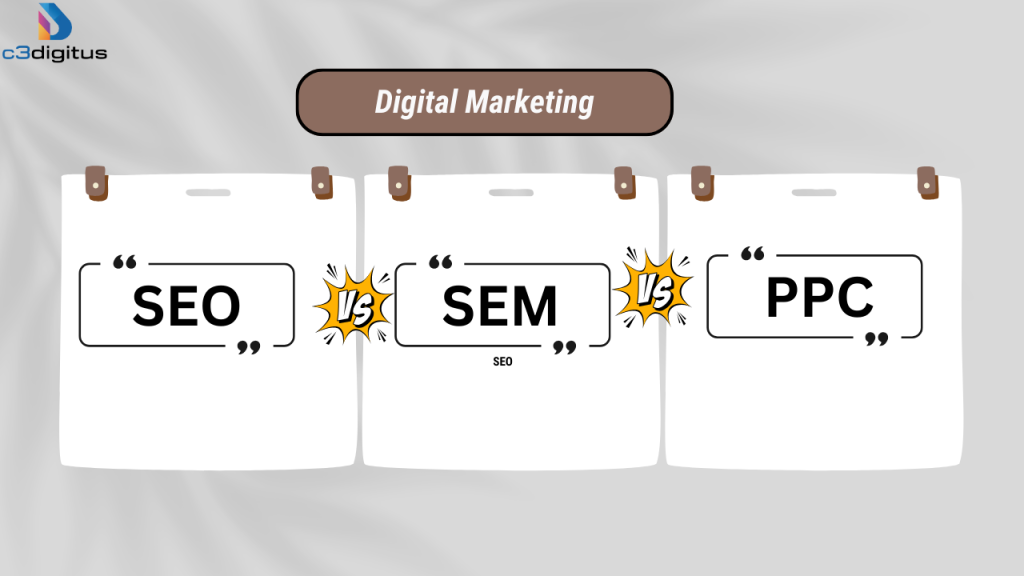
SEO (Search Engine Optimization):
Think of SEO as making your website like a well-organized library. You arrange your books (web pages) so that people can easily find what they’re looking for using the library’s catalog (search engine). SEO involves improving your website so that search engines, like Google, notice it and show it to people who are searching for related topics. It’s about getting your site to rank higher in the free search results, and it doesn’t cost anything except your time and effort.
SEM (Search Engine Marketing):
SEM is like having a special section in the library where you can display your books prominently. It includes both organizing your books well (SEO) and paying for a spot on a prominent display (paid ads). SEM covers all strategies to make your website more visible on search engines, which includes both the free and paid methods.
PPC (Pay-Per-Click):
PPC is like paying for a special ad spot in the library where you only pay when someone actually picks up your book (clicks on your ad). You choose specific keywords related to your business, and your ad shows up when people search for those keywords. You only pay when someone clicks on your ad, not just for showing it.
Fact Checks About SEO
SEO Used to Be Simple
SEO used to be pretty straightforward: you wrote an article, and over time, it would rank and start driving you some traffic. But now, with over a billion blogs out there, SEO has become hyper competitive—almost like a sport. The ways you can get traffic and how you achieve rankings have changed quite a bit.
Target Long-Tail Keywords
Targeting specific niche queries is crucial in today’s competitive SEO landscape. This approach helps you gain traffic and secure good search engine placement.
Myth 1: SEO is Free
Although you don’t have to pay for clicks, great SEO does require considerable investment in time and effort. Research, content creation, and optimization all demand significant resources.
Myth 2: Only Professionals Can Do SEO
Anyone can learn the basics of SEO: content creation, website structure, backlinks, and user engagement. These basics are accessible to anyone willing to put in the effort.
Myth 3: SEO takes time
Success with SEO varies; there’s no guarantee. However, with consistent effort and strategic adjustments, great results can be achieved over time. Adaptability allows you to fine-tune your strategy as you build momentum.
SEO can be tough, but with c3digitus, challenges turn into opportunities for growth. As a leading company for SEO in Pennsylvania, we focus on improving every aspect of your online presence, from perfecting technical SEO to enhancing user experience and content quality. We ensure your website benefits from the latest tools and strategies for optimal performance and impressive results. Partner with c3digitus to elevate your digital presence, driving increased traffic, engagement, and conversions for your business.
